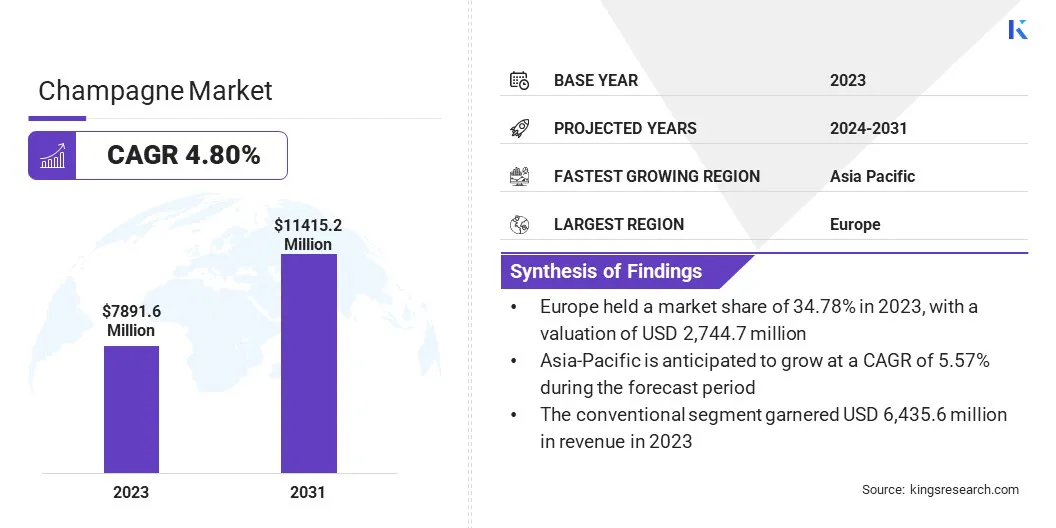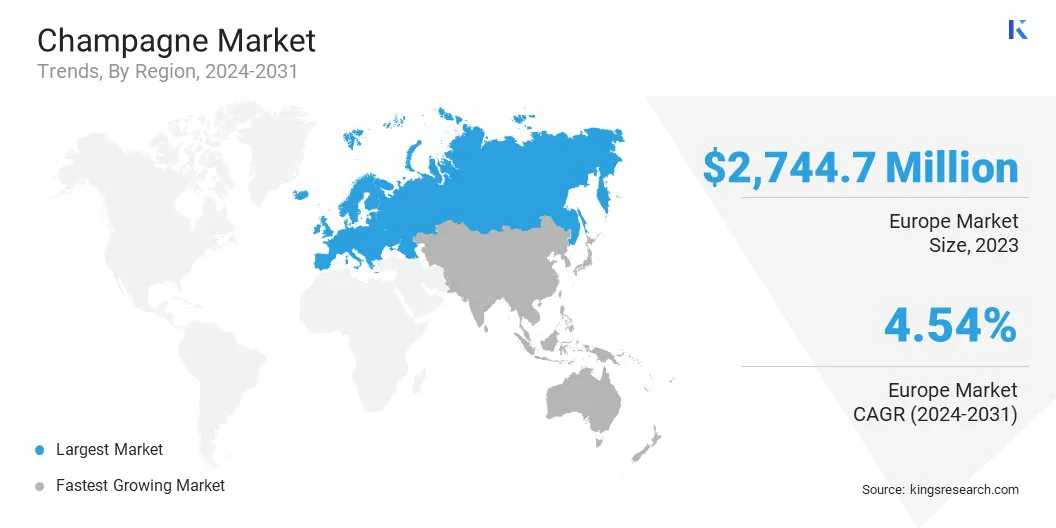Champagne Market Size
The global Champagne Market size was valued at USD 7,891.6 million in 2023, and is projected to grow from USD 8,221.9 million in 2024 to USD 11,415.2 million by 2031, exhibiting a CAGR of 4.80% during the forecast period. In the scope of work, the report includes products offered by companies such as Champagne Bollinger, Champagne Pol Roger, Champagne Taittinger, Krug Champagne, Laurent-Perrier, Louis Roederer, Moët & Chandon, Piper-Heidsieck, Ruinart, Veuve Clicquot and others.
The growth of the market is driven by rising consumer demand for luxury and premium products, effective marketing strategies, increasing disposable incomes, and the expansion of distribution channels.
The champagne market is experiencing robust growth due to growing consumer preference for premium alcoholic beverages, including champagne, driven by rising disposable incomes and changing lifestyles. Additionally, the popularity of champagne as a celebratory drink in various social and cultural settings contributes significantly to its surging demand.
Furthermore, the implementation of effective marketing strategies by industry players, highlighting champagne's association with luxury and sophistication, fuels market growth. Moreover, increasing demand from emerging markets, coupled with the expansion of distribution channels, propels market expansion.
- According to the Comité Interprofessionnel du vin de Champagne, in 2023, total Champagne shipments reached 299 million bottles returning to pre-COVID levels.
The champagne market is a segment of the broader alcoholic beverage industry, with a major focus on the production, distribution, and consumption of sparkling wine characterized by its effervescence and distinctive flavor profile.
Globally, it commands a significant market share within the luxury alcoholic beverage segment, catering to a diverse consumer base that includes affluent individuals and those celebrating special occasions. With a centuries-old heritage, it remains adaptable to changing consumer preferences within a dynamic market landscape.
The market encompasses the production, distribution, and consumption of sparkling wine originating from the Champagne region of France. This sector adhers strictly to specific regulations and production methods outlined by the Comité Interprofessionnel du Vin de Champagne (CIVC). Champagne is characterized by its unique flavor profile, effervescence, and association with luxury and celebration.
Although it originates from a specific geographic area, champagne production has expanded globally, with various regions producing sparkling wines following similar methods but under different names. However, authentic champagne is legally defined and protected under French and international law, thereby ensuring its authenticity and quality.

Analyst’s Review
The champagne market is witnessing robust growth due to key efforts from manufacturers to innovate and meet evolving consumer preferences. Producers are increasingly focusing on sustainable practices, launching organic and biodynamic champagnes to cater to environmentally conscious consumers. New product developments, such as limited edition and personalized champagnes, are enhancing consumer engagement and brand differentiation.
To capitalize on market opportunities, manufacturers should continue investing in sustainable production in order to mitigate the imact of climate change, diversify their product portfolios, and leverage digital marketing strategies to reach younger audiences.
- According to the American Geophysical Union, a study in Nature Reviews Earth and Environment indicated that roughly 70% of the winemaking regions in the world are likely to become unsuitable for grape growing if global temperatures exceeded 2°C above preindustrial levels. The study highlighted that up to 90% of winemaking regions in Italy, Greece, Southern California, and Spain's lowlands and coastal areas are likely to vanish by the end of the century.
Expanding distribution channels, particularly in emerging markets like Asia-Pacific, is crucial for sustained growth. Emphasizing quality and unique experiences further bolster brand loyalty and drive long-term success in the competitive champagne market.
Champagne Market Growth Factors
Growth of the champagne market is propelled by the increasing consumer demand for premium and luxury products. Consumers are continuously seeking unique and high-quality experiences, leading to a surge in the consumption of champagne as a symbol of luxury and celebration. This trend is particularly prominent among millennials and younger generations, who prioritize experiences over material possessions.
Champagne producers and distributors are focusing on innovative marketing strategies and product differentiation to capitalize on this demand, such as introducing limited edition releases, collaborations with luxury brands, and experiential marketing events. Climate change is anticipated to adversely affect grape cultivation and champagne production. Changing weather patterns, including temperature fluctuations and extreme weather events, pose risks to grape yields and quality.
To overcome this challenge, stakeholders in the champagne industry are implementing sustainable practices, such as vineyard management techniques to mitigate the effects of climate change, investing in research and development for resilient grape varieties, and adopting eco-friendly production methods. Additionally, diversifying sourcing regions and exploring alternative grape varieties helps mitigate the risk of crop loss due to climate-related challenges.
Champagne Market Trends
An increasing emphasis on sustainability is emerging as a key trend in the champagne market. Consumers are becoming more environmentally conscious, resulting in increasing demand for sustainably produced champagne. Producers are responding to this rising demand by adopting eco-friendly practices such as organic farming, reducing carbon footprints, and using recyclable packaging.
Certifications such as biodynamic and organic labels are gaining immense popularity, reflecting a commitment to sustainable production methods. This trend is enhancing the environmental credentials of champagne brands and appealing to a growing segment of eco-conscious consumers, thereby influencing purchasing decisions and fostering brand loyalty.
The rise of personalized and experiential offerings caters to consumers who seek unique and memorable experiences, prompting producers to offer customized products and immersive events. This includes personalized labels, bespoke champagne blends, and exclusive tasting events. Additionally, virtual reality and augmented reality are being integrated into marketing strategies to provide interactive and engaging experiences.
This trend is enhancing consumer engagement, creating a stronger emotional connection with brands, and differentiating champagne in a competitive luxury market, thereby stimulating sales and fostering brand loyalty.
Segmentation Analysis
The global market is segmented based on nature, type, product, sweetness, distribution channel, and geography.
By Nature
Based on nature, the market is categorized into organic and conventional. The conventional segment led the champagne market in 2023, reaching a valuation of USD 6,435.6 million. The segment is expanding due to its well-established market presence and consumer familiarity. Conventional champagne benefits from extensive distribution networks and long-standing brand loyalty, making it accessible to a broader audience.
Additionally, the traditional production methods and consistent quality associated with conventional champagne appeal to a wide range of consumers. Marketing efforts and brand heritage further play a crucial role in maintaining its dominant position. the conventional segment continues to attract consumers who prefer reliable and recognized champagne options.
By Type
Based on type, the market is classified into Blanc de Blancs, Blanc de Noirs, Rose Champagne, and Prestige Cuvée. The rose champagne segment is projected to witness significant growth at a CAGR of 6.08% through the forecast period (2024-2031). This expansion is propelled by the increasing popularity of rosé wines and their appeal to younger consumers who seek new and diverse flavor profiles.
Rose champagne offers a visually appealing and flavorful alternative to traditional options, making it a highly preferred portion for celebrations and social events. Moreover, its versatility in pairing with various cuisines enhances its demand. Furthermore, innovative marketing strategies and product launches by producers are boosting its visibility and desirability, contributing to its robust growth trajectory.
By Distribution Channel
Based on product, the market is segmented into vintage and non-vintage. The non-vintage segment secured the largest champagne market share of 71.22% in 2023. Non-vintage champagnes are produced using a blend of wines from multiple years, thereby ensuring a consistent quality and flavor profile that appeals to a broad consumer base. Their relatively lower price point compared to vintage champagnes makes them more accessible to a wider audience.
The flexibility in production allows for a steady supply, thereby meeting consumer demand effectively. Additionally, non-vintage champagnes are widely available and marketed extensively, solidifying their dominance in the market. Furthermore, tTheir reliability and affordability continue to increase their popularity.
Champagne Market Regional Analysis
Based on region, the global market is classified into North America, Europe, Asia-Pacific, MEA, and Latin America.

The Europe champagne market held a significant share of around 34.78% in 2023, with a valuation of USD 2,744.7 million. Europe, particularly France, stands as the historic and cultural heart of champagne production, thus ensuring a strong legacy and brand recognition. The region's well-established vineyards, experienced producers, and adherence to traditional methods guarantee high-quality products.
Additionally, Europe’s affluent consumer base and strong preference for luxury goods boost demand. Moreover, robust distribution networks and tourism in champagne-producing regions contribute to its market dominance. European regulatory protections and designations, such as the Champagne appellation, further reinforce the region’s leading position in the global market.
Asia-Pacific is poised to experience the fastest growth, registering a CAGR of 5.57% through the projection period. This rapid expansion is attributed to rising disposable incomes, an expanding middle-class population, and increasing Westernization of lifestyles and consumption patterns. Additionally, growing awareness and appreciation for luxury products, including champagne, are fueling demand.
The region’s young urban population is increasingly seeking new and premium experiences, thereby boosting champagne sales. Strategic marketing initiatives and expanding distribution networks by key players are further enhancing market penetration. Furthermore, the rising popularity of celebrating special occasions with champagne is contributing to Asia-Pacific champagne market.
Competitive Landscape
The champagne market report will provide valuable insight with an emphasis on the fragmented nature of the industry. Prominent players are focusing on several key business strategies such as partnerships, mergers and acquisitions, product innovations, and joint ventures to expand their product portfolio and increase their market shares across different regions.
Expansion & investments are the major strategic initiatives adopted by companies in this sector. Industry players are investing extensively in R&D activities, building new manufacturing facilities, and supply chain optimization.
List of Key Companies in Champagne Market
The global champagne market is segmented as:
By Nature
By Type
- Blanc de Blancs
- Blanc de Noirs
- Rose Champagne
- Prestige Cuvée
By Product
By Sweetness
- Brut Champagne
- Brut Nature
- Extra Brut Champagne
By Distribution Channel
- On-Trade
- Off-Trade
- Hypermarket/Supermarket
- Specialty Store
- Convenience Store
- Liquor Store
- Online Retails
- Others
By Region
- North America
- Europe
- France
- U.K.
- Spain
- Germany
- Italy
- Russia
- Rest of Europe
- Asia-Pacific
- China
- Japan
- India
- South Korea
- Rest of Asia-Pacific
- Middle East & Africa
- GCC
- North Africa
- South Africa
- Rest of Middle East & Africa
- Latin America
- Brazil
- Argentina
- Rest of Latin America


